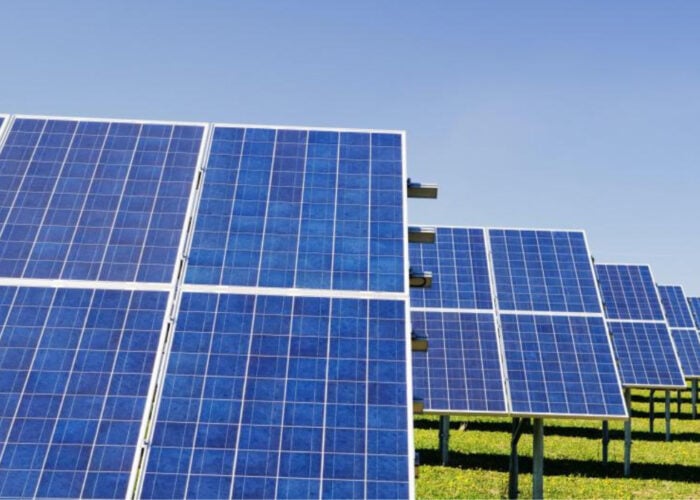Report on the Sermatec 835kWh Modular Energy Storage System and its Alignment with Sustainable Development Goals
On September 11, 2025, SERMATEC announced the launch of a new 835kWh Modular Energy Storage System. This report details the system’s technical specifications, operational advantages, and its significant contributions to achieving the United Nations Sustainable Development Goals (SDGs), particularly in the areas of clean energy, industrial innovation, and climate action.
System Architecture and Technical Specifications
Modular Design and Scalable Capacity
The system is engineered to support the transition to sustainable energy infrastructure by offering a flexible and scalable solution for industrial and grid-scale applications. Its design directly addresses SDG 9 (Industry, Innovation, and Infrastructure) by providing resilient and adaptable technology.
- Core Architecture: Features a 1P104S large-pack configuration with a base capacity of 835kWh, optimized for mid- to large-scale energy requirements.
- Scalability: Allows for parallel expansion up to 6.68MWh, enabling tailored deployment that avoids over-investment and supports future growth.
- Integration Flexibility: Compatible with multiple voltage levels and MVS cabinets, supporting both centralized and string inverter-booster configurations to maximize asset utilization.
Logistical Efficiency and Rapid Deployment
The system’s design prioritizes efficient global logistics and accelerated project timelines, which is crucial for the rapid infrastructure development needed to meet SDG 7 (Affordable and Clean Energy) targets.
- Transportability: A modular transport design weighing under 8 tons facilitates easier land and sea shipment, reducing logistical complexity and deployment time.
- Installation: Standardized interfaces and quick-connect modules streamline the installation process, significantly reducing commissioning time and associated costs.
Contribution to Sustainable Development Goals (SDGs)
SDG 7: Affordable and Clean Energy
The energy storage system is a critical enabler for increasing the share of renewable energy in the global energy mix. By storing energy from intermittent sources like solar, it ensures a reliable and continuous power supply.
- Grid Stability: Enhances grid stability by providing services such as frequency regulation and peak shaving, allowing for higher penetration of renewables.
- Energy Access: Supports both DC and AC coupling in solar-storage hybrid projects, offering flexible solutions for expanding clean energy access.
- Economic Viability: Supports 2, 3, and 4-hour discharge durations, accommodating diverse business models and improving the economic performance of renewable energy projects.
SDG 9: Industry, Innovation, and Infrastructure
The system embodies technological innovation designed to build resilient and sustainable infrastructure. Its advanced features promote the modernization of industrial and utility energy systems.
- Intelligent Management: Incorporates predictive fault diagnostics, remote wireless operation, and OTA upgrades, representing an advancement in industrial technology.
- Data Security: A cloud-edge-device triple-layer security architecture ensures data integrity, a vital component of modern, reliable infrastructure.
- Enhanced Durability: A dynamic thermal management system maintains cell temperature differentials within ≤2.5°C, extending component lifespan by 20–30% and reducing auxiliary power consumption.
SDG 11 (Sustainable Cities) and SDG 13 (Climate Action)
By facilitating the shift away from fossil fuels, the system directly contributes to reducing greenhouse gas emissions and building more sustainable urban environments.
- Peak Shaving: The optional Sermatec Energy Management System (EMS) enables peak shaving, reducing the reliance on carbon-intensive peaker plants in urban areas.
- Climate Resilience: Designed to operate in harsh environments (-30°C to 50°C, up to 4000m altitude) with IP55 protection and an optional C5 anti-corrosion coating, ensuring reliability in a changing climate.
Advanced Safety and Operational Management
Intelligent Operations and Maintenance
The system includes a comprehensive O&M platform that ensures long-term reliability and performance, a key factor for sustainable infrastructure investments.
- Continuous Monitoring: The platform monitors system health in real-time to proactively detect anomalies.
- Expert Support: Dispatches remote or on-site support and conducts regular preventive inspections to guarantee stable operation.
Multi-Dimensional Safety Framework
Safety is a foundational element of the system’s design, ensuring compliance with international standards and protecting assets and personnel.
- Layered Protection: Integrates a 3-level fuse protection, 4-level management control, and a 5-level safety framework covering cell, structural, electrical, and fire protection.
- Fire Suppression: A triple-level fire protection design provides rapid detection and suppression, with insulation materials offering over 2 hours of fire resistance to prevent thermal propagation.
- Global Compliance: Certified to major international standards, including IEC62619, IEC63056, IEC62477, IEC61000, and UL9540A, confirming its adherence to the highest safety benchmarks.
Analysis of Sustainable Development Goals (SDGs) in the Article
1. Which SDGs are addressed or connected to the issues highlighted in the article?
-
SDG 7: Affordable and Clean Energy
The article focuses on an energy storage system, which is a critical technology for increasing the reliability and adoption of renewable energy sources like solar and wind. By enabling grid stability and efficient energy management, the technology directly contributes to building a cleaner and more accessible energy future.
-
SDG 9: Industry, Innovation, and Infrastructure
The article introduces an “innovative 835kWh Modular Energy Storage System,” highlighting advancements in industrial technology. The system is designed for “industrial and grid-scale applications,” directly relating to the development of reliable, sustainable, and resilient infrastructure.
-
SDG 11: Sustainable Cities and Communities
The energy storage system enhances grid stability and reliability through functions like “peak shaving” and “frequency regulation.” This creates more resilient and sustainable energy infrastructure, which is fundamental for the functioning of modern cities and communities, especially in the face of climate change.
-
SDG 13: Climate Action
By facilitating the integration of renewable energy sources (“solar-storage hybrid projects”), the energy storage system helps reduce reliance on fossil fuels, thereby mitigating greenhouse gas emissions. The system’s design for harsh climates and its role in grid resilience also contribute to climate adaptation.
2. What specific targets under those SDGs can be identified based on the article’s content?
-
SDG 7: Affordable and Clean Energy
-
Target 7.2: By 2030, increase substantially the share of renewable energy in the global energy mix.
The article discusses the system’s use in “solar-storage hybrid projects” and its ability to perform “energy time-shift.” This function is essential for storing energy from intermittent renewable sources (like solar) and deploying it when needed, thereby enabling a higher share of renewables in the grid.
-
Target 7.3: By 2030, double the global rate of improvement in energy efficiency.
The system features a “dynamic thermal management system” that “cuts auxiliary power consumption.” This is a direct improvement in the energy efficiency of the storage infrastructure itself.
-
Target 7.a: By 2030, enhance international cooperation to facilitate access to clean energy research and technology… and promote investment in energy infrastructure and clean energy technology.
The launch of this advanced, globally certified (“IEC62619, … UL9540A”) energy storage system represents the promotion and deployment of clean energy technology and infrastructure on an international scale.
-
Target 7.2: By 2030, increase substantially the share of renewable energy in the global energy mix.
-
SDG 9: Industry, Innovation, and Infrastructure
-
Target 9.1: Develop quality, reliable, sustainable and resilient infrastructure.
The article emphasizes the system’s reliability and resilience, noting its design for “stable and reliable operation under the most demanding conditions,” its ability to operate in harsh environments (“-30°C to 50°C environments, up to 4000m altitude”), and its “IP55 protection and optional C5 anti-corrosion coating.”
-
Target 9.4: By 2030, upgrade infrastructure and retrofit industries to make them sustainable… with greater adoption of clean and environmentally sound technologies.
The modular energy storage system is a “clean and environmentally sound technology” designed to upgrade energy infrastructure. Its “compatibility with multiple voltage levels” and ability to integrate into “centralized or string inverter-booster cabins” demonstrate its role in retrofitting and modernizing existing industrial and grid infrastructure.
-
Target 9.1: Develop quality, reliable, sustainable and resilient infrastructure.
-
SDG 11: Sustainable Cities and Communities
-
Target 11.b: By 2030, substantially increase the number of cities and human settlements adopting and implementing integrated policies and plans towards… resilience to disasters.
A stable power grid is crucial for a city’s resilience. The system’s ability to ensure “stable and reliable operation” and its robust design for “harsh climates” contribute to building resilient energy infrastructure that can better withstand climate-related hazards.
-
Target 11.b: By 2030, substantially increase the number of cities and human settlements adopting and implementing integrated policies and plans towards… resilience to disasters.
-
SDG 13: Climate Action
-
Target 13.1: Strengthen resilience and adaptive capacity to climate-related hazards and natural disasters in all countries.
The article highlights the system’s robust design, which includes operation in extreme temperatures (“-30°C to 50°C”), high altitudes (“up to 4000m”), and protection against harsh elements (“IP55 protection,” “C5 anti-corrosion coating”). This enhances the resilience of critical energy infrastructure against climate-related hazards.
-
Target 13.1: Strengthen resilience and adaptive capacity to climate-related hazards and natural disasters in all countries.
3. Are there any indicators mentioned or implied in the article that can be used to measure progress towards the identified targets?
-
Indicators for SDG 7
- Indicator for Target 7.2: The installed capacity of the energy storage systems (835kWh per module, scalable to 6.68MWh) can be used as a proxy indicator for the capacity to integrate renewable energy.
- Indicator for Target 7.3: The stated reduction in “auxiliary power consumption” and the “20–30%” extension of liquid cooling component lifespan are direct measures of increased energy efficiency.
-
Indicators for SDG 9
- Indicator for Target 9.1: The system’s operational specifications serve as indicators of resilience and quality. These include the operating temperature range (-30°C to 50°C), altitude tolerance (4000m), IP55 protection rating, and compliance with international standards (IEC62619, UL9540A).
- Indicator for Target 9.4: The number of units deployed in “industrial parks” or “solar-storage hybrid projects” can serve as an indicator for the adoption of this clean technology in upgrading infrastructure.
-
Indicators for SDG 13
- Indicator for Target 13.1: The technical specifications that demonstrate resilience (e.g., C5 anti-corrosion coating, IP55 rating, wide temperature operating range) are qualitative indicators of strengthened adaptive capacity for energy infrastructure.
Summary Table of SDGs, Targets, and Indicators
| SDGs | Targets | Indicators Identified in the Article |
|---|---|---|
| SDG 7: Affordable and Clean Energy | 7.2: Increase the share of renewable energy. | Energy storage capacity (835kWh, scalable to 6.68MWh) enabling “solar-storage hybrid projects.” |
| 7.3: Double the rate of improvement in energy efficiency. | Reduction in “auxiliary power consumption”; 20-30% longer lifespan of cooling components. | |
| 7.a: Promote investment in clean energy technology. | Launch and global certification (IEC, UL) of an advanced modular energy storage system. | |
| SDG 9: Industry, Innovation, and Infrastructure | 9.1: Develop quality, reliable, sustainable and resilient infrastructure. | Operational parameters: -30°C to 50°C temperature range, 4000m altitude, IP55 protection, C5 anti-corrosion coating. |
| 9.4: Upgrade infrastructure with clean technologies. | Deployment of the system for grid-scale applications, industrial parks, and retrofitting with AC/DC coupling options. | |
| SDG 11: Sustainable Cities and Communities | 11.b: Increase implementation of plans for resilience. | System features enabling grid stability (“peak shaving,” “frequency regulation”) and resilience in harsh climates. |
| SDG 13: Climate Action | 13.1: Strengthen resilience and adaptive capacity. | Technical specifications demonstrating robustness against climate-related hazards (extreme temperatures, corrosion). |
Source: prnewswire.com







